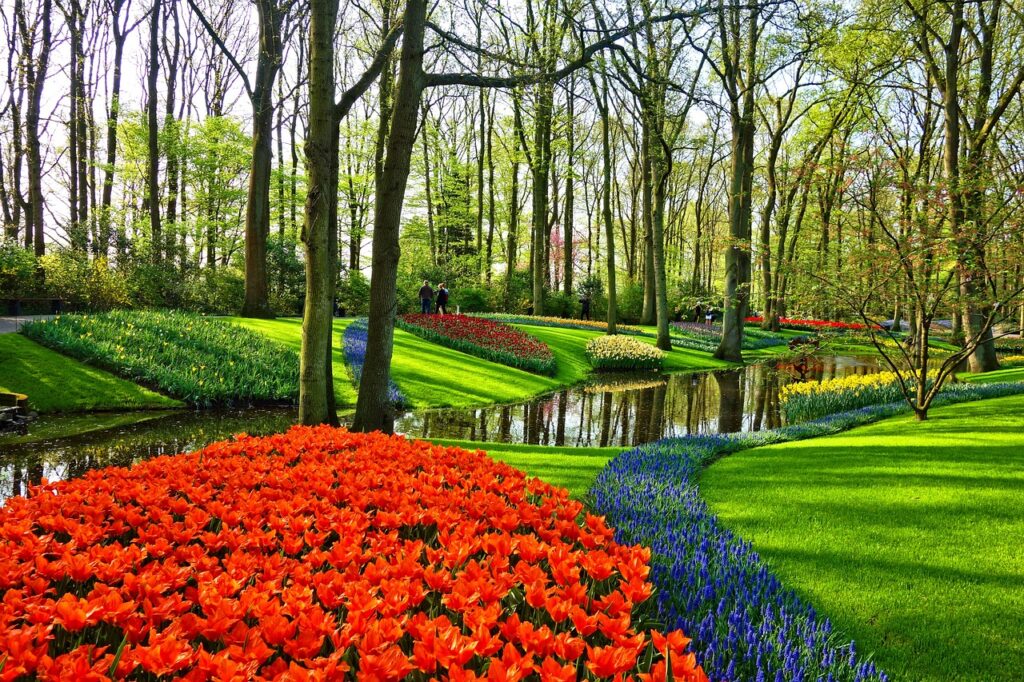
When starting a garden there is a lot to consider including what plants you are going to plant, what time of year, how many and much more.
Have you considered whether you will be sewing your plants in a raised garden beds or in the ground?
Did you know that when considering your garden and keeping it safe for your pets raised garden beds vs in ground gardening have their own set of pros and cons.
This blog post may contain affiliate marketing. I may make a commission on the items you choose to buy. I only post about items that I would recommend.
- I Asked Chat GPT 5 Questions About Pet Safe Gardening And These Were the Results
- Raised Garden Beds Vs In Ground Gardening: Building Your Perfect Garden Layout
- Why Create a Pet Safe Garden?
- 8 Unusual Pet Friendly Crops to Grow That You Can Buy On Amazon
- 7 Strangest Vegetables for Your Pet Safe Fall Garden
Principles of Garden Design

1. Fung Shui– Balancing Your Garden Design
I’m sure you have heard of Fung Shui when it has come to your home but have you considered it for your garden?
It’s not exactly the same thing but it does have the same concept. It’s finding the right locations for your plants that bring “balance” or harmony to your space.
Luckily a lot of your plants can be easily moved with some care but it is also pivotal to reflect on the layout when forming a raised garden beds vs in ground.
Everyone’s style is unique so think over which tactic would be best for your aesthetic:
- Symmetrical Balance: A more formal balance where the layout mirrors the opposing area.
- Asymmetrical Balance: This is a less formal way layout without mirroring but using creative placement.

2. The Heart:
The heart of your garden is the main focus or something that draws your eyes in. I like to build off of the focal point when considering my layout.
In a lot of cases, your focal point can be what is already there like your front door or a sculpture you bought at an auction.
Your focal point should be what makes you happy as gardening should. If gardening does not make you happy then you are in the wrong place!
The focal point should draw your eye to it and serve as a centerpiece for your garden layout.
Some Focal Point Ideas Include (but are not limited to):
- A Bird Bath
- A Statue
- A Bridge
- A Pond
- A Fountain

3. Color Consideration:
This is my favorite part of gardening, picking the colors. There are so many things that you can do with the colors you choose for your garden and even fruits and vegetables come in all different colors even for the same species.
There are different types of color schemes you can consider or you can just go with the colors that makes you happy. Really, that is what gardening is all about.
- Monochromatic: Using shades of a single color for a harmonious and calming effect.
- Analogous: Using colors that are adjacent to each other on the color wheel for a harmonious and cohesive look.
- Complementary: Using colors opposite each other on the color wheel for a bold and contrasting effect.
- Triadic: Using three colors equally spaced on the color wheel for a balanced and vibrant appearance.

4. Plant Variety:
Really the only things to consider when considering plant variety is whether the plant is safe or toxic to pets. I suppose considering which plants are pretty or your family would eat are to be considered as well.
But for the sake of this blog, considering whether the plant is toxic or safe for pets is the most important. That will determine where it should be placed in your garden if you are considering keeping your pets safety in mind.
Ideas to Create Functional and Aesthetically Pleasing Garden Layouts:
1. Define Zones:
Determine the amount of space you have and what that space will be used for.
- Dining
- Celebration
- Pet Play Area
- Relaxation for You or Pets
- Food Production
My husband has always loved the idea of a beer garden. If I were to do one of those for him, I would definitely make a whole cocktail garden with different herbs and edible flowers.
I know he probably wants it to be more masculine than gorgeous flowers everywhere but he’s just going to have to trust my style.
There are also structural elements you can consider when zoning your garden:
- Pathways
- Hedges
- Fencing
2. Garden Access:
Remember how I said earlier that I like to start with my point of focus when designing my garden? Well, my second portion that I consider is the access points to my garden.
This is a crucial part in considering your pets safety as well. Do you need to wall it off from your pets? How will you keep out critters?
Access can also be considered in the way of a raised garden beds vs in ground especially in a small space.
Pathways in and out of the garden area should be wide enough for easy passage and if you are considering keeping your pets from the area, a fence door can be placed.
You may also want to choose the materials you would want to use both if you were using a raised garden beds vs in ground surrounding area.
3. Plant Layering and Depth:
This is honestly, the hardest part for me. I know exactly what I should be doing but I find it very hard to layer plants when you start them from seed.
It is not that I do not know where to place the seeds but I find that the flowers or plants never grow the height or width that I expect.
I have found that the packages do not always speak the exact height so I consider that the plant will be taller than I would think which has worked out for me. The same goes when I consider raised garden beds vs in ground.
4. Container Gardens and Vertical Space:
There are a number of really good container gardens that can add vertical space to your garden. Some even are self watering which makes things so much easier.
I personally hate watering so anything that will water the plants for me is a major plus!
Raised garden beds do not need to be just in the formal sense. These are my favorite that offer vertical space, pet safety allowing you to put the most toxic plants on the top of the tower and composts your waste for you.
In my opinion, it is well worth the money for the ability to cleanly recycle with no extra materials needed. It does it all!
- Utilization: Use containers and vertical gardening techniques to maximize space, especially in smaller gardens. Use the height to keep toxic plants away from your pets.
- Variety: Incorporate a mix of plants in containers, including herbs, flowers, and small shrubs, to add diversity. Putting companion plants together can help your plants.
5. Sustainability and Maintenance:
Planning your garden to work for itself, so to speak, makes gardening easier to maintain and keep your plants growing at a consistent rate.
I have fell in love with using drip tubing because it takes all of the work out of watering your plants. If you get everything set up ahead of time it makes everything so much easier.
That way, you only have to monitor that all of your tubing is working properly and if any plants need less watering as they grow, like watermelon, you make the appropriate changes.
Drip tape also saves water because it will water right up against the plants.
You can also incorporate areas with low-maintenance plants or hardscaping features to reduce upkeep.
Raised Garden Beds vs In Ground
Alright, so we have finally got here. After considering your whole layout and the plants you will be using and your focal points now we need to actually consider whether you will be using raised garden beds vs in ground garden beds.
There are pros and cons to both and special consideration should be taken if you are planting toxic plants.
Let’s define raised garden beds vs in ground…
Raised Garden Beds: Any garden bed that is walled off in some way. A raised garden bed could be built with any material and includes pots. A raised garden bed could be any height.
In Ground Garden Beds: A garden bed that is on the ground and typically uses natural elements rather than bought soil.
Pros to Raised Beds
- Protection from Pets: Raised garden beds can often be more easily protected from pets like dogs or cats by using barriers such as fencing or netting around the bed.
- Decrease Accessibility: Depending on the height of the raised bed, it may be more difficult for pets to reach and potentially damage or eat plants or disturb the soil.
- Easier to Monitor: Because raised beds are contained and elevated, it’s generally easier to see if a pet has been digging or attempting to access the plants.
- Better Soil Control: Raised beds allow you to control the quality and composition of the soil more easily, which can lead to healthier plant growth.
- Improved Drainage: Raised beds typically have better drainage compared to ground-level gardens, especially if your native soil is heavy or poorly draining.
- Warmer Soil: The soil in raised beds warms up faster in the spring, which can extend the growing season and provide better conditions for heat-loving plants.
Cons to Raised Beds
- Jumping or Climbing: Some pets, especially agile cats or large dogs, may still be able to jump into or climb raised beds, particularly if they are not very tall or are easily accessible from nearby structures.
- Limited Space: Raised beds are confined spaces, and if a pet manages to get inside, they may accidentally trample plants or disturb the soil while trying to get out.
- Cost: Building or purchasing materials for raised beds can be more expensive initially compared to ground-level gardening.
- Maintenance: Raised beds may require more frequent watering, as they can dry out faster than ground-level gardens.
- Limited Root Depth: Some plants with deep roots may not thrive as well in raised beds unless they are deep enough.
Pros to In Ground
- Natural Access: Ground-level gardens are more accessible to pets, allowing them to explore and potentially reduce their curiosity about plants by letting them roam.
- More Natural Environment: Pets may enjoy being around ground-level gardens, as they can interact with the plants and soil more freely.
- Natural Environment: Ground-level gardens provide a more natural environment for plants, allowing deeper rooting and more room for plant growth.
- Lower Cost: Typically, ground-level gardening requires fewer materials and initial investment compared to constructing raised beds.
- Easier Planting: It can be easier to plant directly into the ground without the need for building or filling raised beds with soil.
Cons to In Ground
- Potential Damage: Pets can easily dig, roll, or urinate in ground-level gardens, potentially damaging plants or disrupting the soil structure.
- Uncontrolled Access: It can be challenging to completely prevent pets from accessing ground-level gardens without using physical barriers that may obstruct your own access or the aesthetic appeal of the garden.
- Poor Drainage: Depending on your soil type, ground-level gardens may have poorer drainage, which can lead to waterlogging and root rot in some plants.
- Weed Management: Ground-level gardens are more susceptible to weeds spreading from surrounding areas, requiring more effort to control them.
- Soil Quality: Native soil quality may vary and may require more amendment or improvement to support optimal plant growth compared to raised beds.







